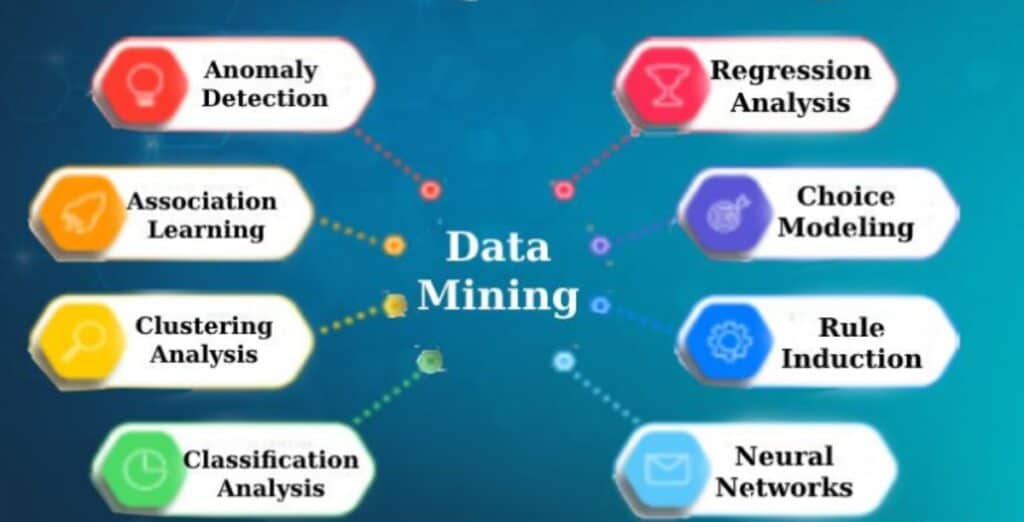Table of Contents
Data Mining definition
The term “data mining” refers to the act of sifting through huge datasets to find patterns and relationships that will assist in solving business problems with analysis of data. Data mining tools and techniques allow businesses to anticipate the future and make better business decisions Data mining is an essential element of data analytics as a whole and is among the primary disciplines of data science, that employs advanced analytics methods to discover useful information within the data sets. On a more specific level it is an element of the knowledge discovery process, which is a data-science technique for gathering information, processing, and analyzing it. Knowledge discovery and data mining in databases are sometimes used interchangeably, however they’re usually regarded as distinct concepts.
What is the reason data mining is crucial?
This is an essential aspect of successful initiatives to improve analytics within businesses. It is used to aid in the development of the business intelligence (BI) and advanced analytics programs that involve the analysis of data from the past, and also in real-time analytics software that analyze streams of data that are generated or gathered.
Data mining is a powerful tool that assists in the planning of various operational strategies for businesses and in managing their operations. This includes functions that involve customers like sales, marketing, advertising and customer support, in addition to manufacturing supply chain management and finance, as well as HR and HR. Data mining is used to detect fraud and security planning, risk management and a myriad of other crucial business applications. It also plays a crucial role in government, healthcare and scientific research, maths and sports and much more.
Data mining process
Data mining is usually performed by data scientists as well as other experienced BI and analytics experts. However, it is also carried out by executives, business analysts and other employees who serve as citizen data scientists within an company. Its primary components are statistical analysis and machine learning and data management tasks that are performed to prepare data to be analyzed. The application of machine-learning algorithmic techniques and artificial intelligence (AI) tools have automated much of the process and made it much easier to analyze massive sets of data like transactions records, databases of customers and log files that are retrieved from mobile apps, web servers and sensors.
Gathering data: relevant data to an analysis program is identified and compiled. The data can be found in different systems of source such as a data warehouse, the data lake, an increasing common storage space within big data environments that include a mix of structured and unstructured information. External sources of data can be used as well. Whatever source the data is from an data scientist typically shifts it to a lake to complete the other steps of the process.
The data preparation phase: This stage includes the steps needed to make the data ready for mining. The process begins with the exploration of data, profiling and pre-processing. Then comes cleaning the data to correct mistakes and other quality issues. Transformation of data is also performed to ensure data sets are uniform, unless a data scientist needs for raw data that is unfiltered for a particular purpose.

The process of mining the data: Once the data is created A data scientist decides the right data mining method and then applies an algorithm or two for the work. Machine learning is a type of application the algorithms must be trained on test sets of data to identify the data that is being sought, before they’re tested against the entire collection of data.
Analysis and interpretation of data: Results are used to develop models for analysis that will assist in making decisions as well as other business activities. Data scientists or any other member of the team of data scientists also has to convey the results to executives in the business and to users typically by using data visualization or using methods for telling stories using data.
Different types of techniques for data mining
There are many methods that can be employed to extract data for various applications of data science. Pattern recognition is an extremely popular application of data mining that’s made possible by various methods, such as anomaly detection, which is designed to find outlier values within datasets. Data mining techniques that are popular include the following kinds:

The concept of clustering is: in this instance data elements with specific characteristics are put in clusters to make use of applications for data mining. Examples include k-means-based clustering, hierarchical clustering, as well as Gaussian mix models.
Regression Another method to identify relationships within datasets, by using probabilities of data values based upon variables. Multivariate regression and linear regression are two instances. Decision trees as well as other classification techniques can be employed to perform regressionstoo.
Analyzing sequences The data can be used for patterns that indicate that a specific sequence of events or values will lead to more.
Neural network: The term “neural network” refers to an algorithm that mimic the activities of humans’ brains. These networks are extremely effective in more complicated pattern recognition applications that rely on deep learning, which is an advanced variant that is a part of machine-learning.
Data mining tools and software
Tools are accessible from a variety of vendors. Companies that provide software for the data mining industry comprise Alteryx, AWS, Databricks, Dataiku, DataRobot, Google, H2O.ai, IBM, Knime, Microsoft, Oracle, RapidMiner, SAP, SAS Institute and Tibco Software, among others.
Many open source technologies can be employed to mine data, such as DataMelt, Elki, Orange, Rattle, scikit-learn and Weka. Some software providers offer open source optionsas well. For instance, Knime combines an open analysis platform that is open source with commercial software to manage applications in data science, while companies like Dataiku and H2O.ai provide free versions of their software.
Benefits
The general benefits of data mining result from the capacity to discover hidden patterns of trends, patterns, correlations and other anomalies within data sets. The information gathered can be utilized to enhance the strategic and business planning using a combination of traditional analytical techniques and the use of predictive analytics.
Effective marketing: This allows marketers to better comprehend the preferences and behavior of customers and enables them to develop specific marketing and advertising campaigns. In the same way, sales teams are able to use the data mining results to boost the conversion rate of leads and to sell additional services and products to customers who already have.
Customer service Through data mining, businesses can spot potential issues with customer service quicker and provide agents in contact centers up-to-date information to use during online chats and calls with customers.
Management of supply chains Companies can identify trends in the market and predict the demand for their products more precisely which allows them to better manage inventories of products and other supplies. Supply chain managers may utilize data mining to enhance distribution, warehouses, and other logistics processes.
Productivity uptime The analysis of operational information from sensors that are installed on manufacturing machines as well as other industrial equipment allows predictive maintenance programs to spot possible issues before they happen and prevent unplanned downtime.
More effective risks control. Risk managers and business executives can more accurately assess cybersecurity, legal, and other threats to the company and create plans to manage the risks.
lower expenses. Data mining helps to reduce costs through efficiency in business processes, as well as reducing redundant and wasteful corporate spending.
In the end, data mining projects could result in higher revenues and profits, and competitive advantages that can set businesses above their competitors.
Industries examples of data mining
The insurance. Insurers rely on data mining to assist in pricing insurance policies, and also in deciding whether or not to accept applications for policies that include risk modeling as well as management of prospective customers.
Manufacturing. Data mining applications for manufacturing companies include efforts to increase uptime and productivity in production facilities Supply chain performance, as well as the safety of products.
Health: It helps doctors detect medical illnesses, treat patients, and analyse x rays as well as other results of medical imaging. Medical research also relies heavily on machine learning, data mining and various other types of analytics.
Retail. Online retailers mine customer information and clickstream data to create targeted marketing campaigns, ads and promotions to individuals who are shopping. Predictive models also drive the recommendation engines that recommend possible purchases to visitors on websites and supply chain and inventory management processes.
financial Services. Banks and credit card companies utilize data mining tools to create financial risk models, spot fraudulent transactions, and verify credit and loan applications. It can also play crucial roles in marketing, and also in identifying opportunities for upselling with customers who are already.
Mining vs. data analytics and warehousing
Sometimes, data mining is regarded as being a part of data analytics. It’s actually an part of data analytics which facilitates the analysis of large data sets to find data that would otherwise be discovered. The information is utilized in the process of data science as well as in different BI or analytics software.
Data warehousing facilitates the data mining process by providing repository facilities for data sets. In the past, historical data was stored in large data warehouses, and smaller data marts created for specific business units or to store certain portions of data. Today, however there are data mining applications usually supported by data lakes that contain both streaming and historical data. They’re based in big data systems, such as Hadoop or Spark, NoSQL databases or cloud object storage.
History of data mining and the origins
Data warehouses, BI and analytics technologies started to become popular in the latter part of the 1980s and the 1990s, bringing with them an enhanced capability to analyze the increasing amount of data that companies were creating and accumulating. It was known as Data mining was popular by the year 1996 at the time that there was First International Conference on Knowledge Discovery and Data Mining was held in Canada.
The conference was organized by the Association for the Advancement of Artificial Intelligence or AARI and also hosted the annual conference for the following three years. From 1999 onwards, this conferenceoften referred to by the name of KDD 2021 or so was primarily organized by SIGKDD which is the group of special interest on the discovery of knowledge and mining data that is part of the Association for Computing Machinery.